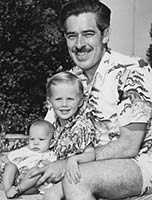William N. Robson
| William N. Robson | |
|---|---|
 William N. Robson and sons in 1948. | |
| Born |
October 8, 1906 Pittsburgh, Pennsylvania |
| Died |
April 10, 1995 (aged 88) Alexandria, Virginia |
| Occupation | Radio director and producer |
William N. Robson (October 8, 1906 – April 10, 1995) was a director and producer of radio programs.
Career
Robson was born in Pittsburgh, Pennsylvania. He attended Yale University, graduating in 1928.[1] Upon graduation he worked as a screenwriter for Paramount Pictures, receiving screen credit for the 1933 film Private Jones.
He spent most of his career involved with radio.[2] He joined CBS in 1936. In 1943, he won two George Foster Peabody Awards, for the drama series Man Behind the Gun and the documentary Open Letter on Race Hatred. He also produced the Columbia Workshop, Suspense, Escape, Luke Slaughter of Tombstone and Doorway to Life.[1] He additionally contributed writing and direction to these projects.
On June 22, 1950, a pamphlet called Red Channels appeared, focusing on the field of broadcasting. Robson was among 151 entertainment industry professionals (erroneously) named in the context of "Red Fascists and their sympathizers".[3] The Red Channels listing for Robson contained four justifications. (1) in 1942 he had been sponsor of an Artists Front to Win the War organized at a meeting in Carnegie Hall; (2) in December 1946 he had made a speech in Los Angeles, protesting Encroachments on freedom of expression; (3) in 1948 he had signed with other artists a "We Are For [Progressive Party candidate Henry] Wallace" advertisement in the New York Times; (4) he was listed as an "associate" on the masthead of the Hollywood Quarterly, a scholarly journal of film, radio, and television published by the University of California Press.[4] This guilt-by-association would affect Robson's career over the next decade.
During the 1950s, he wrote television dramas. In 1961, he joined the Voice of America where he produced documentaries, among them New York, New York on which Garry Moore interviewed celebrities visiting the city, and 200 Years Ago Tonight, a series about the American Revolutionary War produced during the bicentennial year of 1976.[1] His time at the VOA won him four additional Peabody Awards.
With regard to his radio career, Robson would enthusiastically reflect to Dick Bertell in 1976, “The great period of radio was from 1937, '38 really, through the war. It was only 7 years—the golden age of radio. 'Suspense' and 'Escape'—those are the things one does later because one has all the skills at his fingertips. At this time we were trying to find out how to do it. . . We were learning skills, we were sharpening and honing our abilities...when Irving Reis did 'the Fall of the City' in the spring of '37 [it was written] by Archibald MacLeish—one of America's outstanding poets—a man who was so impressed by the medium of radio that he submitted to Irving Reis and the Columbia Workshop a first play for radio. And who directed that? Irving Reis with all of the director staff of CBS assisting him. .Earle McGill, Brewster Morgan, myself, Bill Spier all assisting. Orson Welles as narrator, Burgess Meredith as chief orator. Names that we conjure with now that were just kids then, just kids. That was the time."
Robson died at his home in Alexandria, Virginia, due to complications of Alzheimer's disease[1] on April 10, 1995. He was survived by his wife Shirley, his three sons, and one grandson.
References
- ↑ 1.0 1.1 1.2 1.3 Burt A. Folkart, "William Robson; Radio Producer-Director," Los Angeles Times, April 17, 1995.
- ↑ Obituary, New York Times, April 13, 1995.
- ↑ Schrecker, Ellen (2002). The Age of McCarthyism: A Brief History With Documents. Bedford/St. Martins. p. 244. ISBN 0-312-29425-5.
- ↑ Barnouw, Erik (1968). A History of Broadcasting in the United States : Volume 2: The Golden Web. 1933 to 1953. Oxford University Press, USA. p. 281. ISBN 0195004752.
External links
- Reminiscences of William N. Robson: Oral history, 1966 (Columbia University: Radio Pioneers Project)
- 1976 long form interview at |The Golden Age of Radio
|